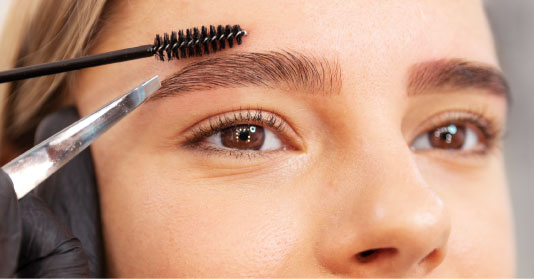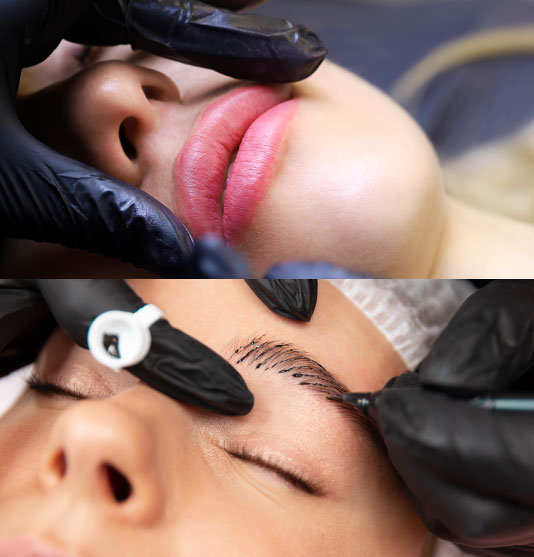Microblading: What it is and how it works
Find out what microblading is, how long it lasts and how to look after your eyebrows after this treatment. Learn how it is different from micropigmentation and more.


What is microblading and how does it work?
Eyebrow microblading is a semi-permanent beauty treatment with a natural-looking finish that helps to rebuild, thicken and even better define our eyebrows. It is the perfect technique for people who are tired of spending time making-up their brows every day, or who simply want a personalised design to fill in any gaps in their eyebrows.
With this technique, we get a natural-looking, long-lasting result with low maintenance. Furthermore, when any extra brow hairs grow, you can pluck them out and clean them easily.
There are several types of microblading. The most common are micro and nanoblading. The difference between them is the type of blade that is used, but both techniques ultimately aim to create as natural a look as possible. Unlike other available brow treatments, such as microshading or micropigmentation, the microblading finish is notable because it does not have an artificial-looking finish or a make-up effect.
How long does microblading last: Is it a permanent treatment?
Microblading does not last forever. It lasts for around a year (although it can last even up to two years) because it is performed on the epidermis, but it also depends on your skin type, application and the care afterwards. To achieve a longer-lasting better finish, you should always follow recommendations after treatment. You should go back at least once a year to keep your brows looking perfect and natural.


Microblading vs. micropigmentation: What’s the difference?
Micropigmentation is the predecessor of microblading. The former consists of injecting coloured pigment into the skin to create the shape of the eyebrows, give them volume, to cover up any imperfections and to give them a better aesthetic appearance. This technique can also be used in other areas such as lips, eyes or to draw freckles.
Microblading, on the other hand, comes from traditional Japanese tattooing, consisting of drawing the shape of our eyebrows hair by hair, adapting it to the specifics of each person.
The main differences between microblading and micropigmentation are as follows:
- Method: micropigmentation penetrates the skin deeper (between the dermis and epidermis layers), whereas microblading is superficial (only the epidermis). Hence, micropigmentation is considered to be permanent makeup, and microblading semi-permanent.
- Instruments: micropigmentation is done using a dermograph machine, which has a needle with a tip to draw the hairs one by one and a needle with three to five tips to shade or fill in. Microblading, on the other hand, uses a small metal pen, similar to a scalpel, to create fine lines that imitate hair.
- Duration: this depends on skin type, age, hormonal factors and care. In general, micropigmentation can last for 2 to 3 years, whereas microblading lasts between 8 and 12 months.
Essential tips for post-procedure care
- Don't touch or scratch: after treatment some pigment might leak from your brows and look bright and shiny. They may even itch or sting. You may be strongly tempted to rub or scratch the area, but you will have to make a conscious effort not to.
- Proper hygiene: although it is a minimally invasive technique, without complications, it must heal properly without any drawbacks. You should let your brows air dry and clean them following the specialist’s instructions. You should also avoid applying makeup to them or any other external agents that could contaminate the area.
- Apply the recommended post-treatment cream: this technique causes tiny lesions to the skin, which must heal and regenerate properly. The specialist will recommend a cream, usually one that is rich in minerals to help set the colour. It should contain Panthenol, an anti-inflammatory, regenerating healing ingredient. You will also be advised to apply cream containing solar protection (SPF).
- Avoid prolonged exposure to water: as part of the post microblading treatment care, you should avoid your eyebrows coming into contact with water for the following 10-15 days, particularly if it contains chlorine. You should also avoid saltwater.
- Avoid sweating and excessive humidity: sports, saunas and very high temperatures and humidity levels can all contribute to hindering the setting of the pigment.
- Protect yourself from the sun: this should always be the number one rule, but even more so if you have just undergone this treatment. You will have to protect your eyebrows, not just with SPF (your specialist will tell you which one to use), but also in other ways such as sunglasses, hats, sunshades... The sun not only damages, dries out and causes premature ageing of the skin, it also degrades the colour.
- Don’t pick at your brows: you might see small dandruff-type flakes in your brows. This is dead skin mixed with the pigment. It is important not to pick them off, as, if you do, you will pull out the pigment too.
- Go for a touch-up session: after your first treatment, your specialist will make an appointment for a touch-up session. This depends on each specialist and how your treatment evolves, but it is usually around 30 days after the first treatment. This touch-up improves the colour and/or any areas that need it can be touched up.

What do you think about?
Share comments, opinions and tricks with the Community







